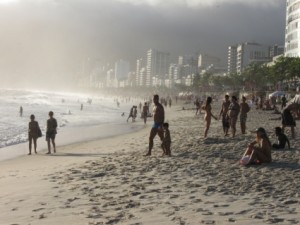
Photo © Michael Sommers.
In recent blog posts, I’ve made numerous allusions to the many changes, propelled by unprecedented economic growth, that are currently taking place in Brazil. Perhaps no place, however, is suffering quite so many transformations as the city of Rio de Janeiro.Spurred on (maybe obsessed is a better word) by its double hosting duties—of the 2014 World Cup and the 2016 Olympic Games—the city is undergoing metamorphosis on a massive scale. Major projects currently underway range from extending subway lines and revamping the historic, but dilapidated port zone to cracking down on drug-related crime and improving security in and around Rio’s notorious favelas by installing Police Pacification Units (UPPs), specially trained community police forces that have had considerable success in quelling violence and restoring safety to numerous communities throughout the city.
According to Brazil’s 2010 Census, findings of which were released last week, the city’s demographics are undergoing some significant alterations.All this rapid growth and change has had a pronounced impact on Rio’s residents as well. According to Brazil’s 2010 Census, findings of which were released last week, the city’s demographics are undergoing some significant alterations. Limited space to grow (courtesy of Rio’s iconic beaches and mountains) and soaring real estate prices—particularly in the wealthier Zona Sul neighborhoods such as Copacabana, Ipanema, and Leblon (where prices have quadrupled in the last year)—have sent unprecedented numbers of Cariocas migrating en masse to the much newer and more affordable Zona Oeste neighborhoods that extend westward along the coast from Leblon.
Over the last 10 years, the population has been eroding in all the Zona Sul’s swankiest neighborhoods – by 8.7 percent in Ipanema, 8.4 percent in Gávea, and 7.9 percent in Jardim Botânico. While Copacabana’s overall population has fallen too, the legendary beach bairro continues to shelter Brazil’s largest concentration of senior citizens, a fact that is apparent to anyone who strolls along its iconic 4.5-km long mosaic boardwalk.
Meanwhile, during this same period, the population of the Zona Oeste has exploded by 110 percent. Novos ricos (nouveau riche) are flocking in unprecedented droves to the soulless condo –and-mall-studded beachfront areas of Barra and Recreio dos Bandeirantes, whose urban design was modeled after that of suburban Miami, but whose endless swath of beach, measuring some 12 kilometers, is one of Rio’s finest, luring bronzers, surfers, and sports enthusiasts. Meanwhile, Cariocas with lesser financial means have been crowding the inland, working-class bairros of Jacarepaguá and Campo Grande (which, with over 330,000 inhabitants, now lays claim to being the city’s most populous neighborhood).
Interestingly, a reverse trend is taking place among many of the city’s favelas. Despite an overall rise in wages and record low unemployment, not to mention a notable drop in birth rates, the favelas of the Zona Sul have actually witnessed an increase in residents. One of the largest favelas in the world, for example, Rocinha, whose Cubist jumble of houses overlooks the tony neighborhoods of Gávea and São Conrado, saw its population grow by 23 percent over the last decade.
At the same time, some favelas in the Zona Oeste—including the region’s largest, Cidade de Deus (City of God), which achieved global recognition following the success of director Fernando Meirelles’ 2002 film of the same name—have seen their number of inhabitants dwindle, although not always by choice. The fact is that, in an effort to develop and “clean up” the Zona Oeste—where the majority of Rio’s 2016 Olympic Complex will be located—the city of Rio has taken to forcibly ejecting residents from their (illegally built) homes. In return, these urban exiles are offered either some form of financial restitution or housing in far-flung, hastily built complexes, often lacking in infrastructure and proximity to services.
According to local councilman Eliomar Coelho, government authorities are using the World Cup and the Olympics as an excuse to reclaim land, which can then be sold to developers intent on cashing in on the city’s frenzied real estate market. “A big opportunity has been missed,” confessed Coelho in an interview accorded to BBC Radio 4. “Instead of being better off as a result of the boom, these people will end up worse off.”